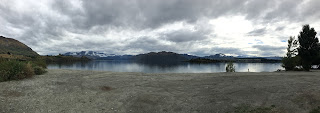What follows is a bit of natural history, with photos and short movies we took of wildlife we have seen here. You can also click on the embedded links for more information.
 |
| Lake Wanaka pano shot |
 |
| Jeremy enjoying some tug-of-war with the island's most popular dog breed |
Before people arrived, New Zealand’s vertebrates (animals with
spines, unlike insects or snails or other animals with exoskeletons) were
exclusively those that could fly or swim across the ocean. Many of these
pioneers had descendants that would be unique in the world - either retaining
characteristics that were lost elsewhere, or by developing new traits, causing
them to become new species.
For example, the parrots in New Zealand are
either green (keas) or brown (kakas), in stark contrast with their brightly
colored new world relatives. Without mammal predators (who can’t see color),
raptors such as the giant eagle (who can) exert the greatest selective
pressure. It is way too dangerous to be bright red or blue!
 |
| Look at the wingspan on this big boy! |
One of the most surprising animals we have seen
so far is the royal albatross (click here for a live feed of the population we visited). This is one of the rare giant birds to survive
here, albeit just barely. We saw them at a conservation area in Dunedin- they
have an astonishing wingspan of up to 3.3m (10.8ft) and to see them paragliding on the
sea breeze is to be transported to a prehistoric era.
Fortunately, they are now protected and populations are doing well. Of course, the seal pups, as they are aptly called, have enough challenges with other sea mammals hunting them; we even saw some sea lions hanging around hoping for a seal dinner.
I admit, it is a strange experience taking a
hike through the forest and not seeing any squirrels or chipmunks- and hardly
any birds since most are drab colored and hide so well. It all adds to the
unique Middle-Earth experience.


1 comment:
Thanks for sharing, so interesting!
Post a Comment